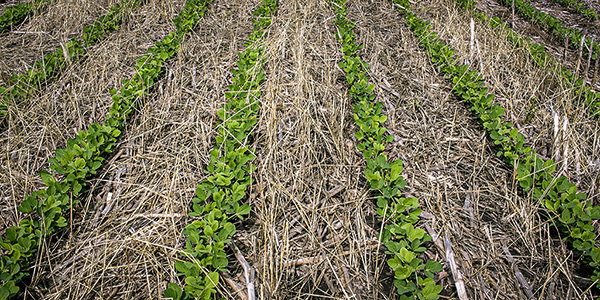AGRONOMICSUPPORT
YOU CAN TAKETO THE FIELD
Planting Into Cover Crops
There are a few things to consider when it comes to planting into cover crops. First, what crop are you planting this spring? And second, what cover crop do you have planted in the field now? A common scenario is cereal rye planted as a cover crop, with corn or soybeans planted into it. Let’s take a look at those scenarios and make sure your bases are covered.
Planting Corn into Cereal Rye
Planting corn into cereal rye presents plenty of challenges. First, you’ll need to have a planter setup that can cut through some residue to get good seed to soil contact. Another challenge that comes to people’s mind is the allelopathy given off by rye. I’m here to tell you that the allelopathy is nothing more than something to talk about. I’ve had years of experience with cover crops on our own farm, as well as looking at it across a wide range of acres, and I have not seen anything that I can attribute to allelopathy stunting or killing corn. Researchers and Professors at Iowa State University share the same views on this. The allelopathy is real, but there is not enough concentration of it to cause any serious issues.
The second, and much larger, issue is planting seeds into substantial biomass. If the rye is allowed to grow too much in the spring, it will begin to tiller and branch out. When this happens, it creates almost 100% ground cover or shade. You can avoid this by spraying the rye to terminate it before the plants reach about six inches in height. This is critical, because when the rye hits its tillering stage, its carbon to nitrogen ratio changes. In the smaller, vegetative stage the carbon to nitrogen ratio is about 26:1, and when it’s fully grown it’s about 82:1. This means that the longer you let the rye grow, the higher carbon content it has, making it slower and more difficult to break down. If you spray the rye at 6 inches tall or less it will be mostly broken down by the time the corn emerges, which allows the corn to capture all the sunlight. If you let the rye grow past six inches tall, it can take well into the season, or even into the following season, to break down the rye. This would keep the ground shaded and very cool when your corn plants are emerging, and they wouldn’t be able to capture all the sunlight they should.
Another side effect of letting the rye grow tall is that when that carbon to nitrogen ratio rises, it means the rye is tying up more of your plant available nitrogen, as well. So even if you apply 200lbs of nitrogen, your corn may only have access to a small percentage of it and the nitrogen won’t be available again until the rye is broken down.
Planting Soybeans into Cereal Rye
Planting soybeans into cover crops is a much safer and easier bet than corn, and I always recommend this for first-time cover crop users. I’ve seen everything from planting into rye that is killed early to planting into rye that is three to four feet tall and still growing. I’m not sure there is a perfect answer when it comes to planting soybeans into rye, as long as you have a planter setup that can get good and consistent seed placement.
Cover crops have a lot of benefits when you plant soybeans into them, with one of the biggest being weed suppression. My recommendation for a first-time cover crop user planting soybeans would be to terminate the rye at least 24 hours prior to planting. This will maximize the cover crop’s use as a weed suppressant, but also allow your soybeans to emerge with relatively little ground shade left.
More Information on Planting into Cover Crops
There are a lot of things to consider when planting into any cover crop, and I’ve only covered a few scenarios in this article. If you have specific questions about what to do on your farm, please reach out to myself or your local Agronomist. Thank you for choosing LG Seeds for #Plant22!
More Information:
Iowa State University Extension and Outreach
Advance Cover Crops





